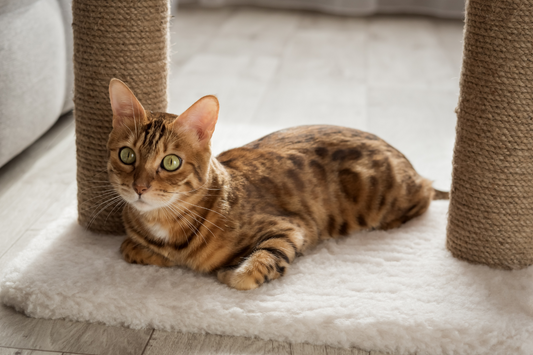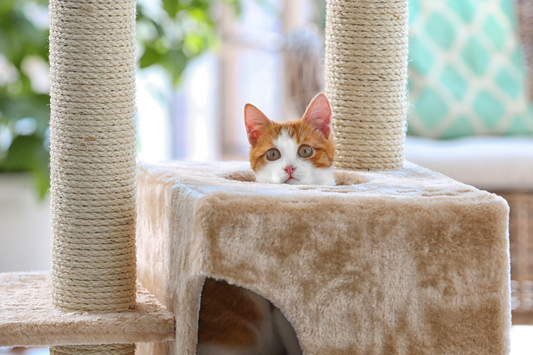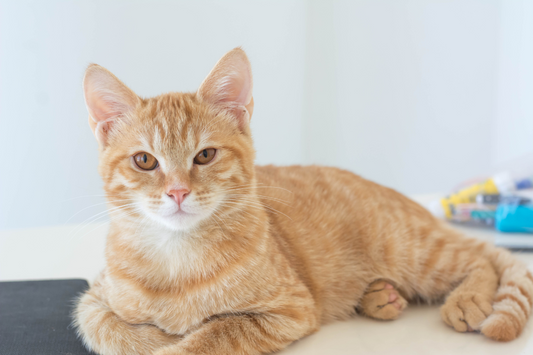
If you’ve ever noticed your cat returning to the same corner of the sofa or the same leg of a table to scratch, you're not alone. Many cat owners ask: Do cats have a favorite scratching spot? The answer is a resounding yes, but the “why” behind this behavior goes deeper than you might think.
Understanding cat scratching behavior is essential for creating a cat-friendly home while protecting your furniture. Let’s explore what makes a spot a cat’s favorite and how to use it for your advantage.
Why Do Cats Scratch?
Scratching is a natural and necessary behavior for cats. It helps them:
· Sharpen their claws by removing dead outer layers
· Stretch and exercise their limbs and muscles
· Relieve stress or frustration through a physical outlet
· Mark territory both visually and with scent (through glands in their paws)
So, scratching is far more than mischief; it's instinctual and emotionally driven.
Yes, Cats Have Favorite Scratching Spots—Here’s Why
Just like humans prefer specific chairs or sleeping positions, cats often return to the same scratching locations. Several key factors drive this behavior:
1. Scent Marking and Familiarity
Cats have scent glands in their paws. When they scratch a surface, they leave behind both a visual and a scent mark. Over time, that spot becomes a familiar, comforting scent zone. This explains why many cats return to the same area repeatedly.
2. Visibility and Territory Signaling
Cats like to mark obvious places, such as door frames, couch arms, or entrance corners, because these areas signal ownership to both humans and other pets. The more prominent the spot, the more likely a cat is to claim it.
3. Texture Preference
Some cats love sisal rope. Others prefer carpet, cardboard, or wood. If the texture of a scratcher mimics a favorite surface (like a couch), they’ll be more likely to choose it. Knowing your cat’s scratching texture preferences can help you find the right scratcher.
4. Habit and Comfort
Once a cat identifies a satisfying scratching spot, it becomes part of their routine. It’s not just about marking, it’s about habit and comfort. This is especially common in multi-cat households where each cat may have “claimed” their favorite areas.
Why Your Cat May Ignore the Expensive Scratcher
It's a common frustration: You invest in a stylish cat scratcher, but your feline friend continues attacking the curtains or chair legs. This often comes down to poor scratcher placement, or a mismatch in texture or height.
According to feline behaviorists:
· Placement matters: Scratchers should be placed near furniture that your cat scratches or in high-traffic zones.
· Height and orientation count: Some cats prefer tall vertical scratchers, others like horizontal or angled surfaces.
· Scent familiarity: A brand-new scratcher doesn’t yet smell like your cat. Rubbing catnip or your cat’s bedding on it can help.
Redirection Strategies That Work
To redirect your cat scratching away from undesirable areas:
1. Place scratchers in preferred locations, especially near where your cat already scratches.
2. Use positive reinforcement with treats, toys, or catnip to make the scratcher more appealing.
3. Block access to off-limit areas using double-sided tape or furniture covers temporarily.
4. Make scratching rewarding: Praise or play with your cat near the scratcher to associate it with positive experiences.
Over time, your cat will transfer their “favorite” status to the new, approved scratching spot.
How to Identify Your Cat’s Favorite Scratching Spot
To work with your cat’s instincts, observe their behavior:
· Where do they scratch first thing in the morning?
· Which surface or room gets scratched the most?
· Do they return to one specific object again and again?
Once you identify that sweet spot, place a quality scratcher there, one that matches the preferred angle and texture. This makes transitioning much easier.
My Take
So, do cats have a favorite scratching spot? Absolutely. And once you understand the why, you can build a more harmonious home by guiding their behavior instead of battling it.
By recognizing your cat’s preferences for location, texture, and routine, and using expert-backed redirection methods, you can protect your furniture while giving your feline exactly what they need: comfort, stimulation, and a sense of ownership.











